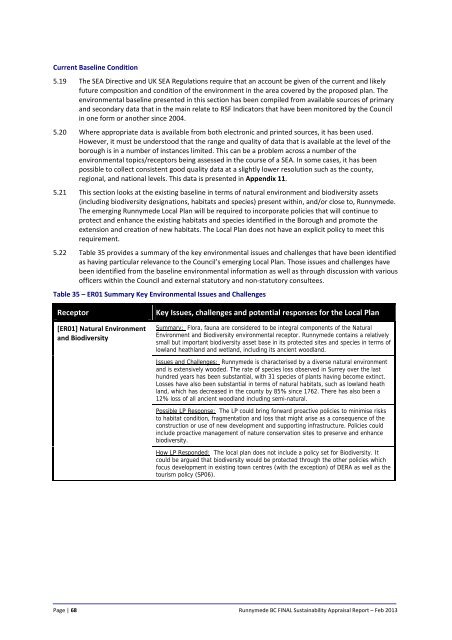DRAFT Sustainability Appraisal Report for the Emerging Local Plan ...
DRAFT Sustainability Appraisal Report for the Emerging Local Plan ...
DRAFT Sustainability Appraisal Report for the Emerging Local Plan ...
Create successful ePaper yourself
Turn your PDF publications into a flip-book with our unique Google optimized e-Paper software.
Current Baseline Condition<br />
5.19 The SEA Directive and UK SEA Regulations require that an account be given of <strong>the</strong> current and likely<br />
future composition and condition of <strong>the</strong> environment in <strong>the</strong> area covered by <strong>the</strong> proposed plan. The<br />
environmental baseline presented in this section has been compiled from available sources of primary<br />
and secondary data that in <strong>the</strong> main relate to RSF Indicators that have been monitored by <strong>the</strong> Council<br />
in one <strong>for</strong>m or ano<strong>the</strong>r since 2004.<br />
5.20 Where appropriate data is available from both electronic and printed sources, it has been used.<br />
However, it must be understood that <strong>the</strong> range and quality of data that is available at <strong>the</strong> level of <strong>the</strong><br />
borough is in a number of instances limited. This can be a problem across a number of <strong>the</strong><br />
environmental topics/receptors being assessed in <strong>the</strong> course of a SEA. In some cases, it has been<br />
possible to collect consistent good quality data at a slightly lower resolution such as <strong>the</strong> county,<br />
regional, and national levels. This data is presented in Appendix 11.<br />
5.21 This section looks at <strong>the</strong> existing baseline in terms of natural environment and biodiversity assets<br />
(including biodiversity designations, habitats and species) present within, and/or close to, Runnymede.<br />
The emerging Runnymede <strong>Local</strong> <strong>Plan</strong> will be required to incorporate policies that will continue to<br />
protect and enhance <strong>the</strong> existing habitats and species identified in <strong>the</strong> Borough and promote <strong>the</strong><br />
extension and creation of new habitats. The <strong>Local</strong> <strong>Plan</strong> does not have an explicit policy to meet this<br />
requirement.<br />
5.22 Table 35 provides a summary of <strong>the</strong> key environmental issues and challenges that have been identified<br />
as having particular relevance to <strong>the</strong> Council’s emerging <strong>Local</strong> <strong>Plan</strong>. Those issues and challenges have<br />
been identified from <strong>the</strong> baseline environmental in<strong>for</strong>mation as well as through discussion with various<br />
officers within <strong>the</strong> Council and external statutory and non‐statutory consultees.<br />
Table 35 – ER01 Summary Key Environmental Issues and Challenges<br />
Receptor<br />
[ER01] Natural Environment<br />
and Biodiversity<br />
Key Issues, challenges and potential responses <strong>for</strong> <strong>the</strong> <strong>Local</strong> <strong>Plan</strong><br />
Summary: Flora, fauna are considered to be integral components of <strong>the</strong> Natural<br />
Environment and Biodiversity environmental receptor. Runnymede contains a relatively<br />
small but important biodiversity asset base in its protected sites and species in terms of<br />
lowland heathland and wetland, including its ancient woodland.<br />
Issues and Challenges: Runnymede is characterised by a diverse natural environment<br />
and is extensively wooded. The rate of species loss observed in Surrey over <strong>the</strong> last<br />
hundred years has been substantial, with 31 species of plants having become extinct.<br />
Losses have also been substantial in terms of natural habitats, such as lowland heath<br />
land, which has decreased in <strong>the</strong> county by 85% since 1762. There has also been a<br />
12% loss of all ancient woodland including semi-natural.<br />
Possible LP Response: The LP could bring <strong>for</strong>ward proactive policies to minimise risks<br />
to habitat condition, fragmentation and loss that might arise as a consequence of <strong>the</strong><br />
construction or use of new development and supporting infrastructure. Policies could<br />
include proactive management of nature conservation sites to preserve and enhance<br />
biodiversity.<br />
How LP Responded: The local plan does not include a policy set <strong>for</strong> Biodiversity. It<br />
could be argued that biodiversity would be protected through <strong>the</strong> o<strong>the</strong>r policies which<br />
focus development in existing town centres (with <strong>the</strong> exception) of DERA as well as <strong>the</strong><br />
tourism policy (SP06).<br />
Page | 68 Runnymede BC FINAL <strong>Sustainability</strong> <strong>Appraisal</strong> <strong>Report</strong> – Feb 2013

















